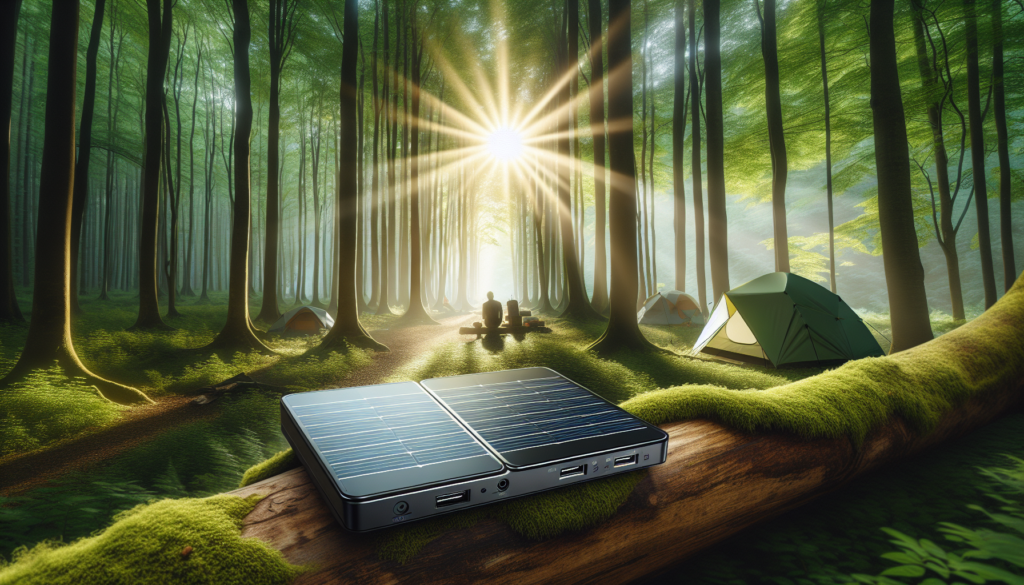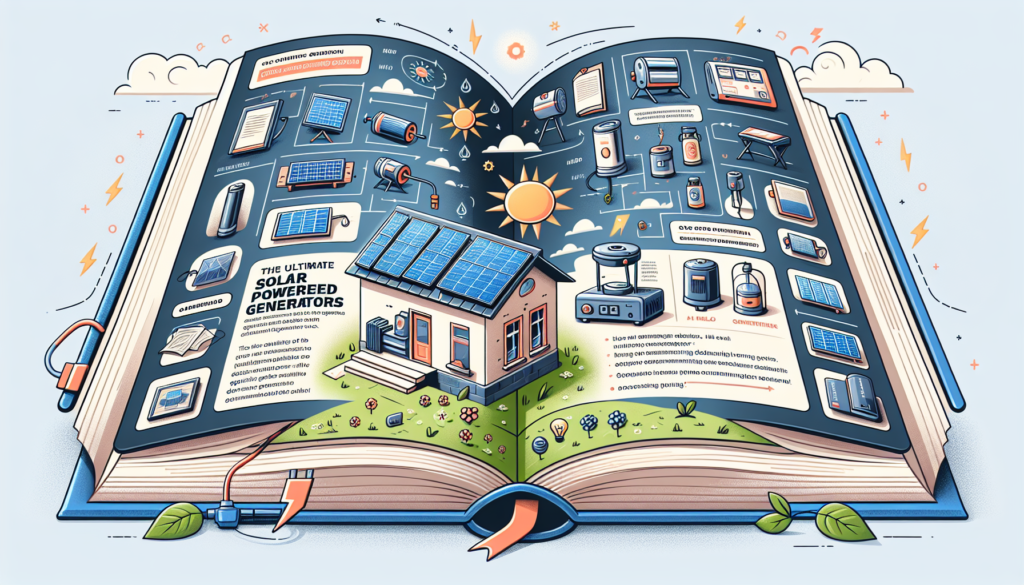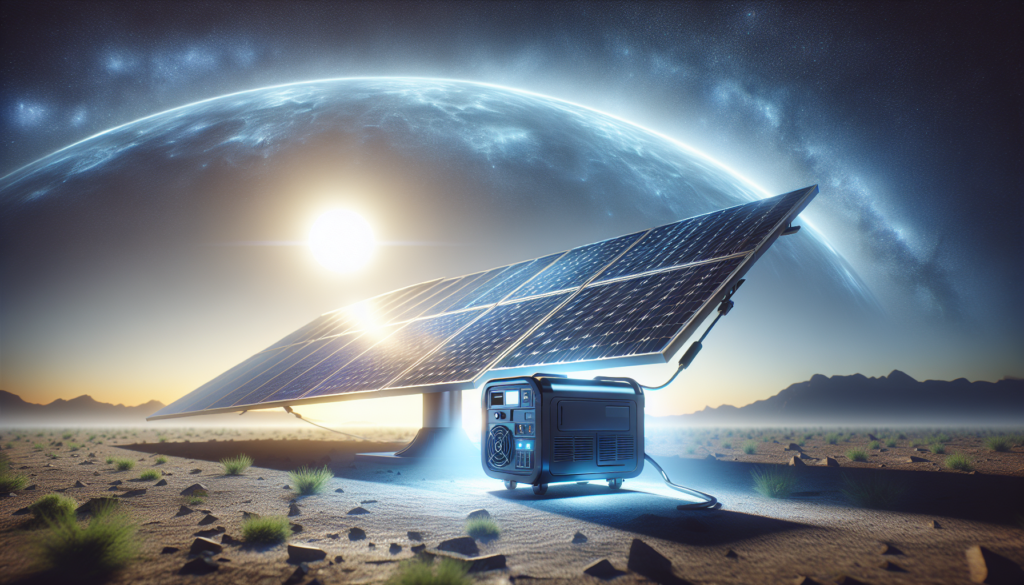Imagine a world where we can power our homes and businesses using a clean, renewable source of energy. A world where we can reduce our dependence on fossil fuels and help combat climate change. This is the potential that solar generators offer, and in this article, we will explore the ways in which these innovative devices are revolutionizing the way we harness power. From providing electricity in remote locations to reducing energy costs, we will discover how solar generators are paving the way for a brighter and more sustainable future. So sit back, relax, and prepare to be amazed by the possibilities of harnessing the power of the sun.
Benefits of Solar Generators
Renewable Energy Source
Solar generators are an excellent source of renewable energy. By harnessing the power of the sun, solar generators convert sunlight into clean, green electricity. Unlike traditional fuel-powered generators that rely on fossil fuels, solar generators produce energy without emitting harmful greenhouse gases. With the abundant supply of sunlight, solar generators offer an unlimited and sustainable source of power.
Eco-Friendly and Sustainable
One of the biggest advantages of solar generators is their eco-friendliness. Solar energy is clean and does not contribute to air pollution or climate change. Unlike fossil fuels, solar power generation does not release harmful pollutants that harm the environment and human health. By using solar generators, you can significantly reduce your carbon footprint and contribute to a cleaner and more sustainable future.
Reduced Energy Costs
Solar generators can help you save on your energy costs in the long run. While the initial investment may seem high, the cost of solar panels and other components has been decreasing over the years. Once installed, solar generators generate electricity for free, reducing or even eliminating your reliance on the grid. This means lower electricity bills and potentially significant savings over time. Additionally, some governments offer incentives and tax credits for installing solar systems, further reducing the overall cost.
Components of a Solar Generator
Solar Panels
Solar panels are the heart of a solar generator system. They are responsible for capturing sunlight and converting it into electrical energy. The panels are made up of photovoltaic cells that generate electricity when exposed to sunlight. The number and size of solar panels will depend on the power output you require and the available space for installation.
Charge Controller
A charge controller is an essential component that regulates the flow of electricity from the solar panels to the battery. It ensures that the battery is charged safely and efficiently. The charge controller prevents overcharging, which can damage the battery, and protects against over-discharging, which can shorten its lifespan. Advanced charge controllers also provide monitoring features to keep track of the system’s performance.
Battery
The battery is where the solar generator stores electricity for later use. It acts as a reservoir to store surplus energy generated by the solar panels during the day, allowing you to use it at night or during cloudy periods. When choosing a battery for your solar generator, consider its capacity and lifespan. Lithium-ion batteries are commonly used due to their high energy density and longer lifespan compared to traditional lead-acid batteries.
Inverter
The inverter converts the direct current (DC) electricity generated by the solar panels and stored in the battery into alternating current (AC) electricity that can be used to power appliances and devices. AC electricity is the standard form of electricity used in homes and businesses. Inverters come in different sizes and power ratings, so it is essential to choose one that can handle your power needs.
Types of Solar Generators
Portable Solar Generators
Portable solar generators are compact and lightweight systems that are designed for easy transportation and use on-the-go. They are ideal for camping, outdoor activities, and powering small devices such as smartphones, laptops, and small appliances. Portable solar generators usually consist of a foldable solar panel, a small battery, and an integrated inverter, making them a convenient and reliable power source in remote locations.
Backup Solar Generators
Backup solar generators are designed to provide a backup power supply during grid outages or emergencies. They can be integrated with your existing electrical system, providing seamless power transfer when the grid is down. Backup solar generators prioritize storing and using electricity from solar panels and the grid, ensuring you have a reliable power source when you need it most. These systems are scalable and can be customized to meet your specific power needs.
Off-Grid Solar Generators
Off-grid solar generators are designed for complete energy independence. They are suitable for remote locations without access to an electrical grid. Off-grid systems typically consist of larger solar panels, multiple batteries, and a powerful inverter. These generators can provide electricity for an entire cabin or off-grid residence, powering appliances, lighting, and other electrical needs. Off-grid solar generators require careful planning and sizing to ensure they meet the energy demands of the property.
Applications of Solar Generators
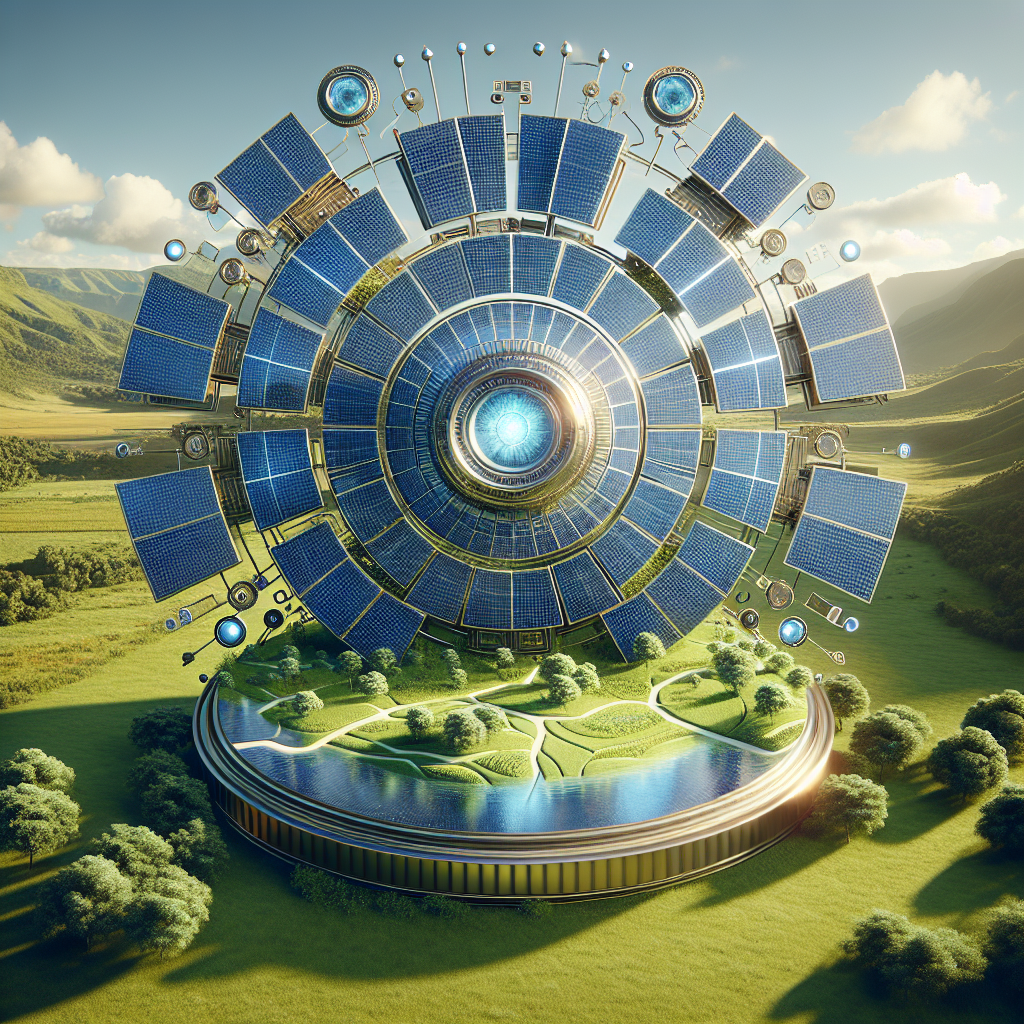
Outdoor Activities
Solar generators are perfect for outdoor enthusiasts and adventurers. Whether you’re camping, hiking, or RVing, portable solar generators allow you to have a reliable power source in remote locations. You can charge your electronic devices, run camping lights, power small appliances, and even run a mini-fridge – all without the need for noisy and polluting fuel generators. With a portable solar generator, you can enjoy the great outdoors while still having access to the power you need.
Emergency Situations
During emergencies or natural disasters, the power grid may be unstable or completely down. This is where backup solar generators shine. With a backup solar generator, you can ensure that critical devices like medical equipment, communication devices, and lights remain operational. Whether it’s a storm, earthquake, or other unforeseen events, having a backup solar generator can provide peace of mind knowing that you have a reliable and independent source of power.
Remote Locations
In remote and off-grid locations, solar generators offer a sustainable and cost-effective solution for powering homes, farms, and businesses. Instead of relying on costly diesel generators or expensive power line extensions, off-grid solar generators can provide electricity without the need for a connection to the electrical grid. This enables communities in remote areas to have access to clean and reliable electricity, improving their quality of life and supporting economic development.
Factors to Consider When Choosing a Solar Generator
Power Output
When selecting a solar generator, consider the power output it can deliver. The power output should align with your energy needs, including the appliances and devices you intend to power. Consider the wattage requirements of your devices and estimate the total electricity consumption to ensure the solar generator can meet your demands. It’s better to choose a system with a slightly higher power output capability to accommodate future power needs.
Battery Capacity
The battery capacity determines how much electricity the solar generator can store. It is crucial to choose a battery with sufficient capacity to meet your energy needs during periods of low sunlight or at night. Consider the size and energy requirements of your appliances and devices, as well as the expected usage patterns. A larger battery will provide longer backup power and reduce the reliance on solar panels and the grid.
Portability
For portable solar generators, portability is a significant factor to consider. Look for lightweight and compact systems that are easy to carry and transport. Features like built-in handles, collapsible solar panels, and compact design make it convenient to take your solar generator on camping trips, picnics, or any outdoor adventure. Additionally, consider the assembly and disassembly process, as well as the weight, when choosing a portable solar generator.
Charging Options
Solar generators can be charged in different ways. Most solar generators use solar panels to convert sunlight into electricity, but some models also offer the option to charge from a wall outlet or a car’s cigarette lighter socket. Having multiple charging options provides flexibility in different situations. If you live in an area with limited sunlight or need a backup charging option, consider a solar generator that offers alternative charging methods.
Installation and Maintenance of Solar Generators
Selecting the Right Location
Choosing the right location for your solar panels is crucial to maximize their efficiency. Ideally, the solar panels should be installed in a location that receives the most sunlight throughout the day. This means avoiding shading from trees, buildings, or other obstructions. Mounting the solar panels on a south-facing roof or at an angle that aligns with the sun’s trajectory will optimize their exposure to sunlight and maximize energy production.
Mounting Solar Panels
Properly mounting solar panels is essential for their performance and longevity. Whether you’re installing solar panels on a roof, ground-mounted system, or a portable setup, ensure that the panels are securely fixed and aligned correctly. Follow the manufacturer’s recommendations and guidelines for installation, including the use of appropriate mounting brackets and hardware. If you’re unsure about the installation process, it’s recommended to hire a professional to ensure the panels are installed safely and correctly.
Checking Connections and Wiring
Regularly check the connections and wiring of your solar generator system to ensure they are secure and functioning properly. Loose or damaged connections can affect the performance and efficiency of the system. Inspect the wiring for any signs of wear, fraying, or damage, and replace or repair as needed. It’s advisable to follow the manufacturer’s maintenance guidelines and seek professional assistance if you encounter any technical issues.
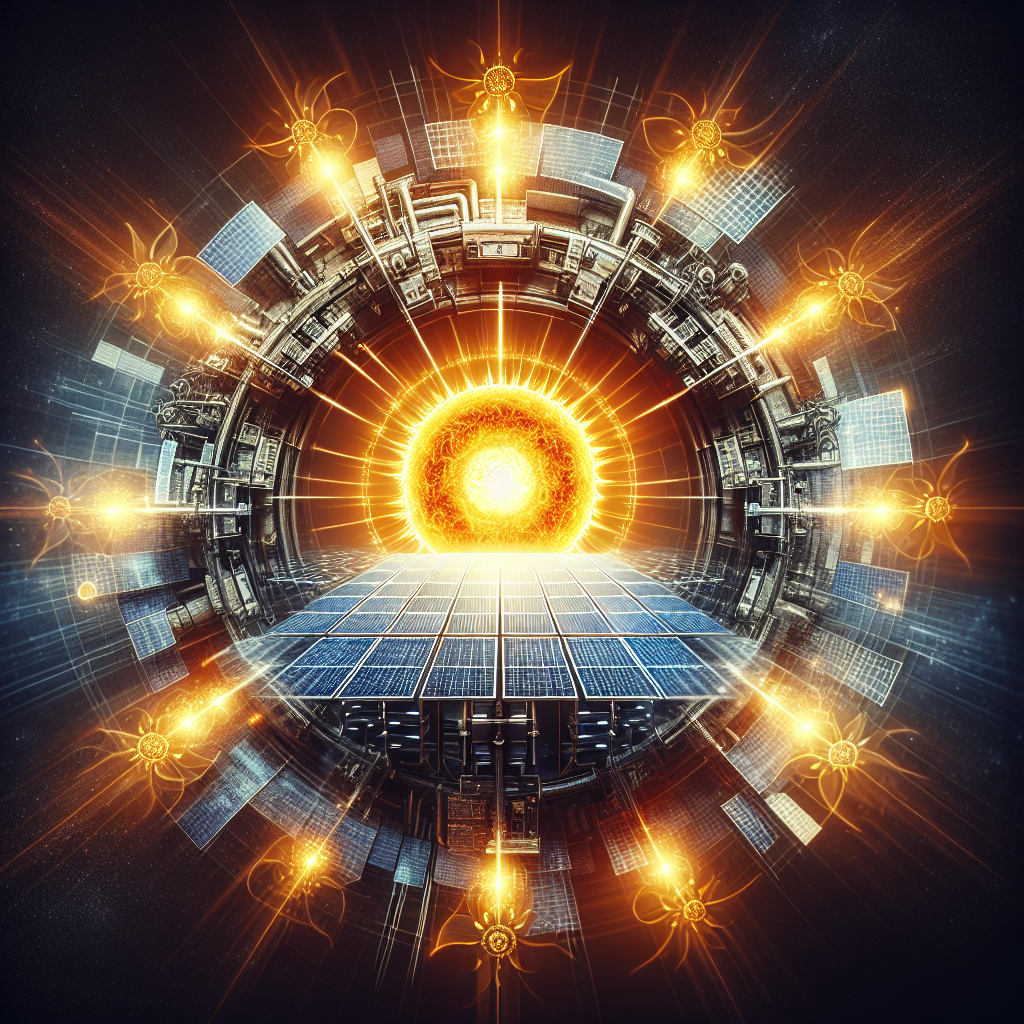
Regular Cleaning and Maintenance
Solar panels require regular cleaning to ensure maximum efficiency. Dust, dirt, leaves, and other debris can accumulate on the solar panels and reduce their ability to capture sunlight. Clean the panels with a soft cloth or sponge and mild soapy water, avoiding abrasive materials or harsh chemicals that could damage the panels. Additionally, monitor the battery’s performance and ensure it is properly maintained, following the manufacturer’s recommendations for charging and maintenance.
Advancements in Solar Generator Technology
Efficiency Improvements
Advancements in solar panel technology have significantly improved their efficiency over the years. New materials and manufacturing processes allow solar panels to capture more sunlight and convert it into electricity with higher efficiency. This means that smaller panels can generate the same amount of power as larger panels, making them more scalable and versatile. Increased efficiency also means that solar generators can produce more power even in low-light conditions, improving their overall performance.
Integration with Smart Home Systems
Solar generators are now increasingly compatible with smart home systems, allowing for seamless integration and control. You can monitor and manage your solar generator remotely through smartphone apps or web interfaces. This enables you to track energy production, adjust system settings, and even receive notifications of any maintenance or performance issues. Integration with smart home systems provides convenience, automation, and real-time access to information about your solar generator system.
Battery Technology Innovations
Battery technology plays a crucial role in the efficiency and performance of solar generators. Advancements in battery technology have led to the development of more efficient and durable battery chemistries. Lithium-ion batteries, for example, offer higher energy densities, longer lifespans, and faster charging capabilities compared to traditional lead-acid batteries. These advancements not only increase the storage capacity of solar generators but also improve their overall reliability and lifespan.
Challenges and Limitations of Solar Generators
Dependence on Sunlight Availability
Solar generators are highly dependent on the availability of sunlight. They produce the most electricity when exposed to direct sunlight, and their performance may be negatively affected by cloudy or overcast conditions. In areas with limited sunlight or during winter months, solar generators may not generate enough electricity to meet all power demands. However, advancements in solar panel technology and battery storage are helping to mitigate this challenge, allowing for increased energy production and storage capacity.
Storage Capacity
The storage capacity of solar generators is limited by the capacity of the batteries used. While battery technology has improved significantly, current battery storage capacities may not be sufficient to meet prolonged high-energy demands. To overcome this limitation, it is essential to properly size the solar generator based on your energy needs and consider adding additional batteries for extended backup power. It’s important to strike a balance between storage capacity and other factors like cost, size, and efficiency.
Initial Costs
The initial investment required for installing a solar generator system can be a barrier for some individuals and businesses. While the cost of solar panels and other components has decreased over the years, the upfront costs can still be significant. However, it is essential to consider the long-term benefits and potential savings from reduced energy costs. In addition, various financial incentives and tax credits are available in many regions, making solar generators more affordable and attractive for potential buyers.
Limited Power Output
Solar generators have specific power output capabilities, and their capacity may not be sufficient to power high-energy-consuming appliances and systems simultaneously. It is essential to consider the power rating of the solar generator and estimate your energy needs accordingly. If you have high-energy-demanding appliances like air conditioners or electric ovens, you may need to install a larger solar generator system or consider alternative power sources like grid connection or backup generators for such high-demand scenarios.
Case Studies and Success Stories
Solar Generators in Disaster Relief Operations
Solar generators have played a critical role in disaster relief operations worldwide. When natural disasters strike and the power grid is down, solar generators provide emergency electricity to power essential medical equipment, communication devices, lighting, and refrigeration for storing vital supplies. These portable and reliable power sources have been used in various disaster scenarios, including hurricanes, earthquakes, floods, and wildfires. Solar generators provide immediate relief and reduce the reliance on fossil fuel-based generators, which can be challenging to supply during emergencies.
Solar Generators in Developing Countries
Solar generators have the potential to transform the lives of millions in developing countries. Many communities in remote areas lack access to electricity and rely on costly and polluting alternatives such as kerosene lamps or diesel generators. Solar generators offer an affordable, clean, and sustainable solution for providing electricity to these underserved communities. By harnessing the abundant sunlight, solar generators can power homes, schools, health clinics, and small businesses, improving the quality of life and supporting economic development.
Solar Generators in Residential Applications
Solar generators have gained popularity in residential applications, providing homeowners with a reliable backup power supply and reducing their dependence on the grid. During grid outages or emergencies, solar generators can automatically switch to battery power, ensuring that critical appliances and devices remain operational. Additionally, homeowners can take advantage of the excess energy generated by their solar panels and store it in batteries for later use, reducing their electricity bills and reliance on the grid during peak hours.
Future of Solar Generators
Increased Adoption and Market Growth
The future of solar generators looks promising, with increased adoption and market growth predicted in the coming years. As solar technology continues to evolve and become more accessible, more individuals and businesses are recognizing the benefits of solar generators. The decreasing costs and attractive financing options make solar generators a viable and cost-effective solution for clean and sustainable energy. This trend is expected to drive further adoption and market growth, making solar generators a mainstream option for power generation.
Grid-Connected Solar Generators
Grid-connected solar generators, also known as grid-tied systems, are becoming increasingly popular. These systems allow solar generators to be connected to the electrical grid, enabling homeowners and businesses to sell excess electricity back to the utility company, earning credits or income. Grid-connected solar generators provide a two-way flow of electricity, allowing for seamless integration of renewable energy into the existing power grid. This not only maximizes the utilization of solar energy but also contributes to the stability and reliability of the grid.
Solar Generators as Backup Power for Electric Vehicles
With the rise in electric vehicle (EV) adoption, solar generators can play a crucial role as backup power sources for charging EVs. A solar generator system can generate electricity during the day, store it in batteries, and then use that stored energy to charge EVs overnight or during periods of low sunlight. This not only helps reduce the reliance on the grid for EV charging but also maximizes the use of clean and renewable energy. Solar generators can provide an eco-friendly solution that complements the growing demand for electric vehicles.
In conclusion, solar generators offer numerous benefits as a renewable energy source. They provide eco-friendly and sustainable power, reduce energy costs, and offer independence from the grid. Understanding the components, types, applications, and factors to consider in choosing a solar generator is crucial in making an informed decision. With advancements in technology, solar generators continue to evolve, becoming more efficient, integrating with smart home systems, and utilizing better battery technology. While solar generators face challenges such as sunlight dependence and initial costs, they are being successfully utilized in disaster relief operations, developing countries, and residential applications. The future of solar generators looks promising, with increased adoption and market growth, as well as potential integration with the grid and electric vehicles. Harnessing the power of the sun through solar generators is not only a responsible choice but an investment in a cleaner, greener, and more sustainable future.

